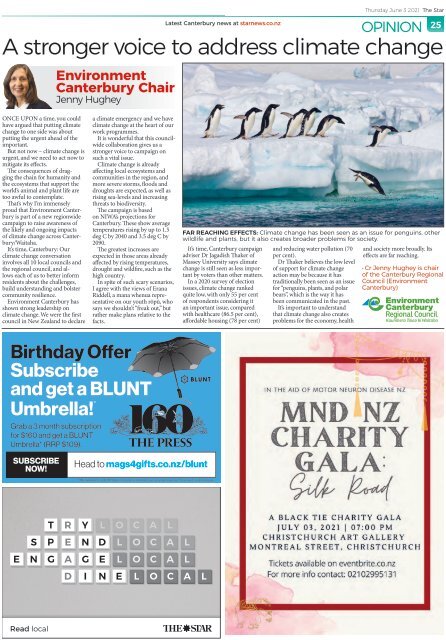The Star: June 03, 2021
Create successful ePaper yourself
Turn your PDF publications into a flip-book with our unique Google optimized e-Paper software.
since Environment Canterbury<br />
climate-change emergency<br />
A stronger voice to address climate change<br />
by sea-level rise this century and threatened and facing increased<br />
our productive and protected land pressures due to river system<br />
Environment<br />
jeopardised by the arrival and change.<br />
spread of new, exotic weeds and Wetlands are also ecosystems<br />
Canterbury Chair<br />
pests from warmer climates. at-risk nationally and regionally,<br />
Jenny Hughey<br />
All these eventualities have degraded by draining, damming<br />
to be planned and prepared for, and diversion affecting their<br />
ONCE and enhance UPON that a time, work. you could a climate fleet hybrid emergency or long-range and we have electric<br />
and Environment Canterbury ability to sequester carbon,<br />
have That argued work that included putting setting climate climate by 2022. change Carbon at the emissions heart of our from<br />
will remain in the vanguard of cleanse freshwater and mitigate<br />
change up a climate-change to one side was integration about work air travel programmes. across the organisation<br />
these climate change efforts. flooding, as well as impacting on<br />
One example is the $40 million biodiversity and mahinga kai.<br />
putting programme the urgent in the ahead Long-term of the Plan It are is offset wonderful via our that own this biodiversity councilwide<br />
programmes. collaboration gives us a<br />
protection project, completed putting greater emphasis on the<br />
Waimakariri River flood<br />
With biosecurity, we are<br />
important. 2018-28, ensuring climate change<br />
was But actively not now considered – climate change across is stronger According voice to to campaign a Madworld on report<br />
late last year. <strong>The</strong> network of risks of new pests establishing<br />
urgent, workstreams, and we increasing need to act visibility now to such in 2019, a vital our issue. gross emissions were<br />
floodgates and stopbanks will in Canterbury. Warming<br />
mitigate of the science its effects. and what we know Climate 2253 tonnes change of carbon is already dioxide<br />
protect half a million people and temperatures, changing soils and<br />
about <strong>The</strong> consequences the impact of of climate dragging<br />
change the on chain Canterbury, for humanity and and liaising communities removals of in 7883 the region, tonnes and of CO2-<br />
affecting (CO2) local equivalent, ecosystems compared and with<br />
$8 billion of community and new land uses mean new weeds<br />
business assets from a possible especially, will be able to gain a<br />
the on the ecosystems issue with that iwi support and regional the more equivalent severe storms, through floods our efficiency and<br />
world’s animal and plant life are droughts are expected, as well as<br />
“super flood”.<br />
better foothold across the region.<br />
partners, other local authorities efforts and from forestry planting<br />
too awful to contemplate.<br />
rising sea-levels and increasing<br />
<strong>The</strong> last major flood was in More broadly, we have to<br />
and central government.<br />
across 2700 hectares.<br />
That’s why I’m immensely threats to biodiversity.<br />
December 1957, when parts curb reliance on fossil fuels and<br />
As an organisation, we have <strong>The</strong> changing climate will pose<br />
proud that Environment Canterbury<br />
is part of a new regionwide on NIWA’s projections for<br />
Kainga were swamped by river alternatives, such as electricity and<br />
<strong>The</strong> campaign is based<br />
of Coutts Island in Belfast and find environmentally suitable<br />
also made significant progress in many risks to life and livelihood<br />
addressing our own greenhousegas<br />
emissions,<br />
in Canterbury. In recent years<br />
campaign to raise<br />
with<br />
awareness<br />
our<br />
of Canterbury. <strong>The</strong>se show average flow peaking at 3990 cubic hydrogen, to power our public<br />
we have seen how occasional,<br />
the likely and ongoing impacts<br />
Christchurch building receiving a<br />
temperatures rising by up to 1.5 metres per second (cumecs). transport.<br />
but extreme, weather events have FAR<br />
of climate change across Canterbury/Waitaha.<br />
deg C by 2040 and 3.5 deg C by <strong>The</strong> REACHING protection EFFECTS: scheme has Climate been change When has my predecessor been seen Steve as an issue for penguins, other<br />
“market-leading” energy efficiency had huge effects on residents and wildlife<br />
2090.<br />
designed and to plants, defend but Christchurch it also creates Lowndes broader retired problems as chair for of society.<br />
rating<br />
It’s time,<br />
of 5.0<br />
Canterbury:<br />
out of 6 in<br />
Our<br />
the year<br />
<strong>The</strong><br />
infrastructure<br />
greatest increases<br />
around<br />
are<br />
the South It’s from time, a Canterbury flood of as much campaign as 6500 and reducing this council water late pollution last year, (70 he and society more broadly. Its<br />
climate to February change on conversation<br />
the National<br />
expected<br />
Island.<br />
in those areas already adviser cumecs. Dr Jagadish Thaker of per cent). highlighted some of the big effects are far reaching.<br />
involves Australian all Built 10 local Environment councils and affected <strong>The</strong> by driest rising parts temperatures, of our region, Massey Environment University says Canterbury’s climate Dr Thaker changes believes on the the way. low He level was<br />
the Rating regional System council, New and Zealand. allows<br />
<strong>The</strong> each building’s of us to features better inform include high across country. much of the Canterbury tant biosecurity by voters than programmes other matters. is also action deal may with be because the “pressing it has issues” of the Canterbury Regional<br />
drought along the and Marlborough wildfire, such coast the and change leadership is still seen of biodiversity as less impor-<br />
and of support optimistic for climate we would change be able to • Cr Jenny Hughey is chair<br />
residents 184 solar about panels the which challenges, can In Plains, spite are of such expected scary to scenarios, get even In underpinned a 2020 survey by of climate-change<br />
election traditionally climate been change seen and as an sustainability. issue Council (Environment<br />
build generate understanding more than 55,000 and bolster I agree drier. with North-westerly the views of storms Erana are issues, concerns. climate change ranked for “penguins, I share plants, his confidence. and polar As a Canterbury)<br />
community kilowatt hours resilience. of electricity per Riddell, predicted a mana to become whenua more repre-intensesentative<br />
with torrential on our youth alpine rōpū, rainstorms<br />
Canterbury’s distinct braided community, and as a council,<br />
quite low, with only 55 per cent bears”, which is the way it has<br />
year. Environment Canterbury has<br />
who of respondents considering it been communicated in the past.<br />
It’s a year since Environment<br />
shown <strong>The</strong>re strong has been leadership 26% reduction says turning we shouldn’t our braided “freak rivers out,” but into an important rivers and issue, unique compared<br />
Canterbury<br />
wetlands face we are taking some bold steps to<br />
many challenges. <strong>The</strong> rivers form It’s important ensure we to are understand in a better place to<br />
climate per staff change. member We in were emissions the first rather roaring make rapids, plans fuelling relative landslides to the with a healthcare vital ecological (86.5 per link cent), and provide that climate cope with change the also changing creates climate<br />
council since 30 declared in <strong>June</strong> New 2010. Zealand We now to have facts. a climate-change and causing widespread erosion. affordable an abundant housing food (78 supply per emergency<br />
cent) and problems and for the the tests economy, it will set health us. But<br />
access to electric and hybrid<br />
Canterbury’s coastal<br />
nesting grounds for 26 species of there will always be a need to do<br />
JENNY HUGHEY explains what<br />
by sea-level rise this century and<br />
vehicles and hope to have half our communities will be threatened native birds – most classified as more.<br />
the council has been doing.<br />
<strong>The</strong> formal declaration of a<br />
state of climate emergency across<br />
Birthday Offer<br />
Subscribe<br />
and get a BLUNT<br />
Umbrella! *<br />
Canterbury was one of the most<br />
serious, and colourful, moments<br />
in the regional council’s more than<br />
30-year history.<br />
A year ago this Saturday,<br />
at 11.49am, Environment<br />
Canterbury became New Zealand’s<br />
first council to proclaim such an<br />
emergency, formally dedicating<br />
itself to consideration of climate<br />
change at the heart of all it does.<br />
<strong>The</strong> declaration highlighted<br />
that all the work Environment<br />
Canterbury does – from<br />
freshwater management to<br />
biodiversity and biosecurity,<br />
transport and urban development<br />
to air quality, and also regional<br />
leadership NOW! – has a climate change<br />
focus.<br />
Currently, under the Resource<br />
Management Act, regional<br />
councils are required only to adapt<br />
to climate change, not mitigate<br />
it – that responsibility is the<br />
Government’s, but could change.<br />
Even in ‘adapt mode’ many<br />
of Environment Canterbury’s<br />
existing policies and plans already<br />
contribute to reduced emissions.<br />
In declaring the climate<br />
emergency, the Council noted it<br />
would continue to show leadership<br />
on climate-change and do so<br />
without adding new programmes<br />
at ratepayers’ expense. It also gave<br />
staff a clear mandate to continue<br />
Grab a 3 month subscription<br />
for $160 and get a BLUNT<br />
Umbrella* (RRP $109).<br />
SUBSCRIBE<br />
and enhance that work.<br />
That work included setting<br />
up a climate-change integration<br />
programme in the Long-term Plan<br />
2018-28, ensuring climate change<br />
was actively considered across<br />
workstreams, increasing visibility<br />
of the science and what we know<br />
about the impact of climate<br />
change on Canterbury, and liaising<br />
on the issue with iwi and regional<br />
partners, other local authorities<br />
and central government.<br />
As an organisation, we have<br />
also made significant progress in<br />
addressing our own greenhousegas<br />
emissions, with our<br />
Christchurch building receiving a<br />
“market-leading” energy efficiency<br />
rating of 5.0 out of 6 in the year<br />
to February on the National<br />
Australian Built Environment<br />
Rating System New Zealand.<br />
<strong>The</strong> building’s features include<br />
184 solar panels which can<br />
generate more than 55,000<br />
kilowatt hours of electricity per<br />
year.<br />
<strong>The</strong>re has been a 26% reduction<br />
per staff member in emissions<br />
since 30 <strong>June</strong> 2010. We now have<br />
access to electric and hybrid<br />
vehicles and hope to have half our<br />
Head to mags4gifts.co.nz/blunt<br />
Latest Canterbury news at starnews.co.nz<br />
Environment<br />
Canterbury Chair<br />
Jenny Hughey<br />
*Offer available for a BLUNT Metro Umbrella for a limited time only, while stocks last. Terms and conditions apply.<br />
fleet hybrid or long-range electric<br />
by 2022. Carbon emissions from<br />
air travel across the organisation<br />
are offset via our own biodiversity<br />
programmes.<br />
According to a Madworld report<br />
in 2019, our gross emissions were<br />
2253 tonnes of carbon dioxide<br />
(CO2) equivalent, compared with<br />
removals of 7883 tonnes of CO2-<br />
equivalent through our efficiency<br />
efforts and from forestry planting<br />
across 2700 hectares.<br />
<strong>The</strong> changing climate will pose<br />
many risks to life and livelihood<br />
in Canterbury. In recent years<br />
we have seen how occasional,<br />
but extreme, weather events have<br />
had huge effects on residents and<br />
infrastructure around the South<br />
Island.<br />
<strong>The</strong> driest parts of our region,<br />
along the Marlborough coast and<br />
across much of the Canterbury<br />
Plains, are expected to get even<br />
drier. North-westerly storms are<br />
predicted to become more intense,<br />
with torrential alpine rainstorms<br />
turning our braided rivers into<br />
roaring rapids, fuelling landslides<br />
and causing widespread erosion.<br />
Canterbury’s coastal<br />
communities will be threatened<br />
our productive and protected land<br />
jeopardised by the arrival and<br />
spread of new, exotic weeds and<br />
pests from warmer climates.<br />
All these eventualities have<br />
to be planned and prepared for,<br />
and Environment Canterbury<br />
will remain in the vanguard of<br />
these climate change efforts.<br />
One example is the $40 million<br />
Waimakariri River flood<br />
protection project, completed<br />
late last year. <strong>The</strong> network of<br />
floodgates and stopbanks will<br />
protect half a million people and<br />
$8 billion of community and<br />
business assets from a possible<br />
“super flood”.<br />
<strong>The</strong> last major flood was in<br />
December 1957, when parts<br />
of Coutts Island in Belfast and<br />
Kainga were swamped by river<br />
flow peaking at 3990 cubic<br />
metres per second (cumecs).<br />
<strong>The</strong> protection scheme has been<br />
designed to defend Christchurch<br />
from a flood of as much as 6500<br />
cumecs.<br />
Environment Canterbury’s<br />
leadership of biodiversity and<br />
biosecurity programmes is also<br />
underpinned by climate-change<br />
concerns.<br />
Canterbury’s distinct braided<br />
rivers and unique wetlands face<br />
many challenges. <strong>The</strong> rivers form<br />
a vital ecological link and provide<br />
an abundant food supply and<br />
nesting grounds for 26 species of<br />
native birds – most classified as<br />
Thursday <strong>June</strong> 3 <strong>2021</strong> <strong>The</strong> <strong>Star</strong><br />
OPINION 25<br />
threatened and facing increased<br />
pressures due to river system<br />
change.<br />
Wetlands are also ecosystems<br />
at-risk nationally and regionally,<br />
degraded by draining, damming<br />
and diversion affecting their<br />
ability to sequester carbon,<br />
cleanse freshwater and mitigate<br />
flooding, as well as impacting on<br />
biodiversity and mahinga kai.<br />
With biosecurity, we are<br />
putting greater emphasis on the<br />
risks of new pests establishing<br />
in Canterbury. Warming<br />
temperatures, changing soils and<br />
new land uses mean new weeds<br />
especially, will be able to gain a<br />
better foothold across the region.<br />
More broadly, we have to<br />
curb reliance on fossil fuels and<br />
find environmentally suitable<br />
alternatives, such as electricity and<br />
hydrogen, to power our public<br />
transport.<br />
When my predecessor Steve<br />
Lowndes retired as chair of<br />
this council late last year, he<br />
highlighted some of the big<br />
changes on the way. He was<br />
optimistic we would be able to<br />
deal with the “pressing issues” of<br />
climate change and sustainability.<br />
I share his confidence. As a<br />
community, and as a council,<br />
we are taking some bold steps to<br />
ensure we are in a better place to<br />
cope with the changing climate<br />
and the tests it will set us. But<br />
there will always be a need to do<br />
more.<br />
Read local


















